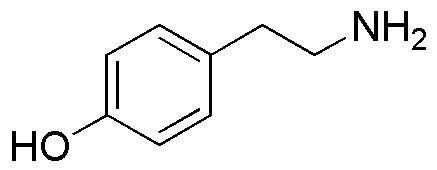2-(4-Hydroxyphenyl)ethylamine is widely utilized in research focused on:
- Pharmaceutical Development: This compound is a key intermediate in the synthesis of various pharmaceuticals, particularly those targeting neurological disorders. Its ability to cross the blood-brain barrier makes it valuable in drug formulation.
- Biochemical Research: It serves as a substrate in enzyme assays, helping researchers understand enzyme kinetics and mechanisms in biochemical pathways.
- Antioxidant Applications: Known for its antioxidant properties, it is used in formulations aimed at reducing oxidative stress in cosmetic products, enhancing skin health.
- Analytical Chemistry: Utilized as a standard in chromatographic techniques, it aids in the accurate quantification of related compounds in complex mixtures.
- Material Science: This compound can be incorporated into polymers to enhance thermal stability and mechanical properties, making it useful in the development of advanced materials.
General Information
Properties
Safety and Regulations
Applications
2-(4-Hydroxyphenyl)ethylamine is widely utilized in research focused on:
- Pharmaceutical Development: This compound is a key intermediate in the synthesis of various pharmaceuticals, particularly those targeting neurological disorders. Its ability to cross the blood-brain barrier makes it valuable in drug formulation.
- Biochemical Research: It serves as a substrate in enzyme assays, helping researchers understand enzyme kinetics and mechanisms in biochemical pathways.
- Antioxidant Applications: Known for its antioxidant properties, it is used in formulations aimed at reducing oxidative stress in cosmetic products, enhancing skin health.
- Analytical Chemistry: Utilized as a standard in chromatographic techniques, it aids in the accurate quantification of related compounds in complex mixtures.
- Material Science: This compound can be incorporated into polymers to enhance thermal stability and mechanical properties, making it useful in the development of advanced materials.
Documents
Safety Data Sheets (SDS)
The SDS provides comprehensive safety information on handling, storage, and disposal of the product.
Product Specification (PS)
The PS provides a comprehensive breakdown of the product’s properties, including chemical composition, physical state, purity, and storage requirements. It also details acceptable quality ranges and the product's intended applications.
Certificates of Analysis (COA)
Search for Certificates of Analysis (COA) by entering the products Lot Number. Lot and Batch Numbers can be found on a product’s label following the words ‘Lot’ or ‘Batch’.
*Catalog Number
*Lot Number
Certificates Of Origin (COO)
This COO confirms the country where the product was manufactured, and also details the materials and components used in it and whether it is derived from natural, synthetic, or other specific sources. This certificate may be required for customs, trade, and regulatory compliance.
*Catalog Number
*Lot Number
Safety Data Sheets (SDS)
The SDS provides comprehensive safety information on handling, storage, and disposal of the product.
DownloadProduct Specification (PS)
The PS provides a comprehensive breakdown of the product’s properties, including chemical composition, physical state, purity, and storage requirements. It also details acceptable quality ranges and the product's intended applications.
DownloadCertificates of Analysis (COA)
Search for Certificates of Analysis (COA) by entering the products Lot Number. Lot and Batch Numbers can be found on a product’s label following the words ‘Lot’ or ‘Batch’.
*Catalog Number
*Lot Number
Certificates Of Origin (COO)
This COO confirms the country where the product was manufactured, and also details the materials and components used in it and whether it is derived from natural, synthetic, or other specific sources. This certificate may be required for customs, trade, and regulatory compliance.

